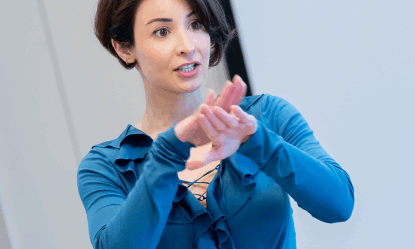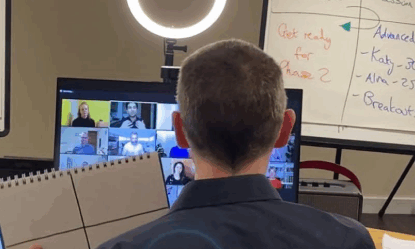When you think about great communicators, whether it’s a charismatic leader, a compelling TED speaker, or a colleague who always seems to nail their presentations, it’s easy to believe they were born lucky, with the gift of gab. But are great communicators born or made? Is social connection inherent or learned? Can presentation and communication skills be taught, or are they innate abilities some people just “have” and others don’t?
The question might seem rhetorical. After all, you’ve probably sat through your fair share of workshops, training, and public speaking courses. You’ve seen the transformation of nervous team members blossoming into confident presenters. But there’s always that lingering question: Are we truly learning, or just going through the motions?
The Myth of the Natural Speaker
First, let’s address a common myth: the “natural” communicator. It’s easy to point to Steve Jobs, Oprah Winfrey, or Richard Branson and say, “See, they’ve got it; it’s in their DNA.” However, we often overlook the countless hours of practice, feedback, and formal training they invested in honing their skills. Jobs, for instance, rehearsed his famous product launches for hours, meticulously planning every word, gesture, and slide transition.
The truth is, while some individuals may start with a higher baseline of comfort or charisma, presentation and communication skills are not fixed traits. They are trainable competencies with the potential to be cultivated, refined, and mastered over time. The “naturals” often just had a head start or more practice in environments where these skills were either necessary or encouraged earlier on.
The Science of Learning Communication
One of the reasons these skills can be taught is because communication is as much about structure as it is about style. A well-delivered presentation isn’t just a string of charming anecdotes and witty remarks; it’s a carefully crafted narrative designed to engage, inform, and persuade. And narratives can be built systematically.
Courses and training programs focus on key elements like:
- Storytelling Techniques: How to structure your message for maximum impact.
- Body Language: How non-verbal cues like eye contact, gestures, and posture affect your audience.
- Vocal Dynamics: Mastering pitch, pace, and pauses to emphasise your message.
- Visual Aids: Creating slides supporting, rather than distracting from, your narrative.
These are teachable components with the promise of transforming a dry presentation into an engaging experience. Moreover, neuroscience research confirms how people can improve performance through practice. Techniques like deliberate practice, where you focus on specific aspects of your performance, and immediate feedback loops can significantly accelerate the learning curve.
Oddly enough, one of the remarkable effects of practice is how it can alter the brain’s structure by enlarging the areas involved in the practised skill. Practice is not simply about “gaining confidence”, it’s about building up your real mental capability – your brain’s power – so the practised technique becomes second nature. You can do it because you’ve done it before.
Breaking Down the Barriers
Now, let’s address the elephant in the room: fear. For many professionals, the barrier isn’t a lack of skill, it’s anxiety. Fear of judgement, fear of failure, and fear of forgetting your lines can turn the most competent leader into a stuttering fool in front of an audience.
Let’s get down to business then. Can you imagine how it would feel to be fearless in front of your audience? Far fetched? Not at all. Here’s how: Through exposure, coaching, and gradual desensitisation, you can learn to manage your fear and leverage the adrenaline you inevitably feel. Techniques such as breathing exercises, visualisation, and even mindfulness can help you stay grounded. Public speaking is like any other skill; the more you do it, the less intimidating it becomes.
Think of it like learning to swim. The first few times in the water, you’re splashing, panicking, and struggling to stay afloat. But with guidance, repeated practice, and building confidence step by step, you eventually find yourself gliding effortlessly across the pool. Maybe not Michael Phelps effortlessly, but still, pretty swan-like.
Real-World Examples
Consider a senior manager I once worked with—we’ll call her Maria. Maria was brilliant at her job, but her presentations were, frankly, painful. She read directly from slides, her voice barely rose above a whisper, and she avoided eye contact like it was a competitive sport. After a few targeted workshops focusing on vocal presence and storytelling, and with some one-to-one coaching sessions, Maria’s transformation was remarkable. She became the go-to presenter for board meetings, known for her clear, persuasive, and engaging style.
Did Maria become a different person? No, she became a better communicator because she learned how to leverage her strengths and address her weaknesses.
It’s a Journey, Not a Destination
The key takeaway is this: Presentation and communication skills are not about perfection; they are about progression. And yes, they can be taught. But like any skill, continuous improvement is essential. Even seasoned speakers can benefit from refining their approach, testing new techniques, and getting feedback.
As senior managers or leaders, you set the tone for communication in your organisation. If you prioritise these skills and invest in training—not just for your teams, but for yourself—you’re sending a powerful message. You’re demonstrating how communication is not just a “nice-to-have” but a critical business competency.
So, next time you find yourself marvelling at a great presentation, remember: the speaker wasn’t born that way. They learned it, just like you can. And maybe knowing the presentation polish is all about how much you’re willing to practice, is the most empowering lesson of all.
Final Thoughts
In the end, teaching presentation and communication skills isn’t about creating clones of famous speakers. It’s about helping individuals find their authentic voice and giving them the tools to express it effectively. The results? More engaging meetings, more persuasive pitches, and a more dynamic workplace. And that’s something every leader can get behind.
So, can presentation and communication skills be taught? Absolutely. The real question is: Are you ready to learn?

















